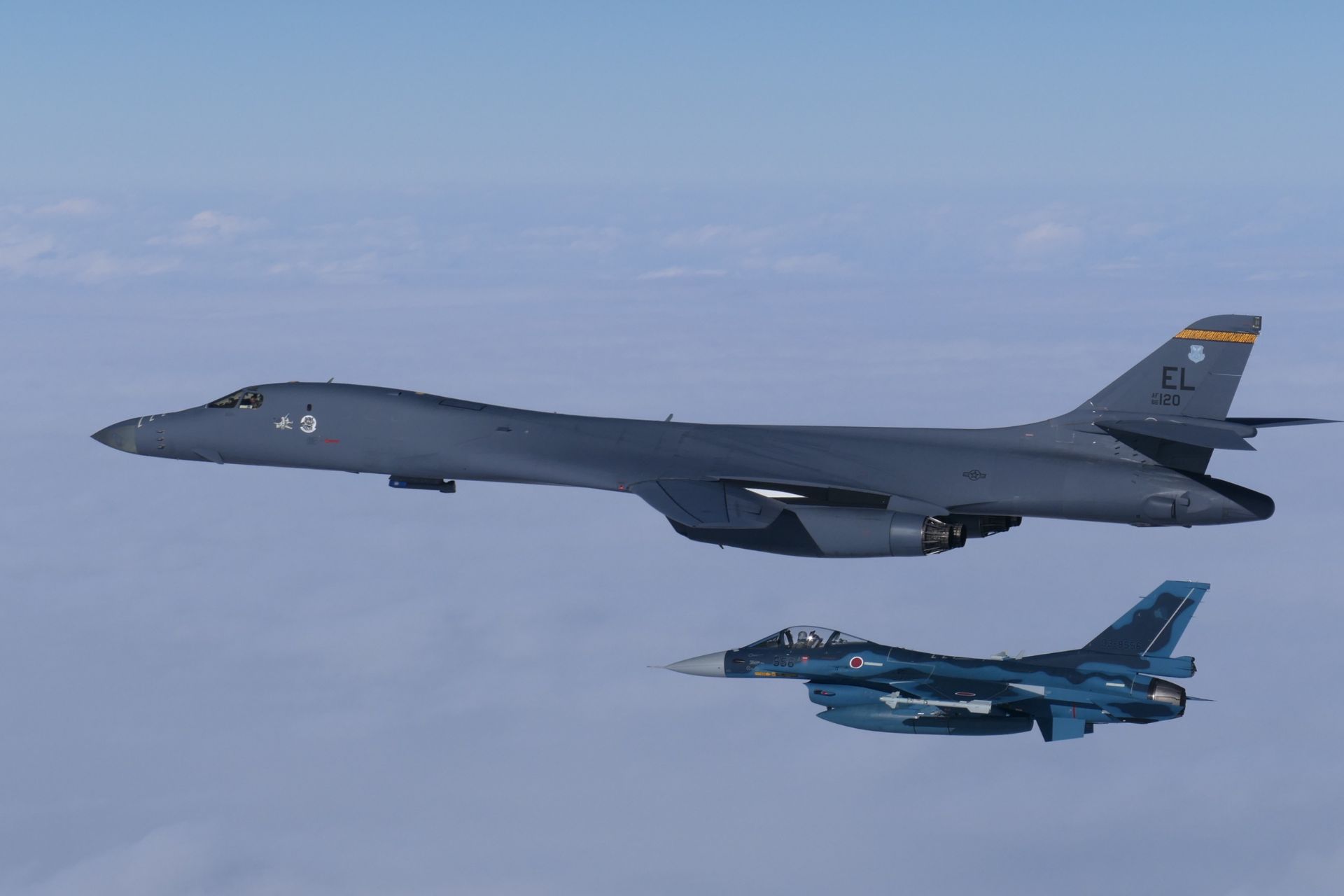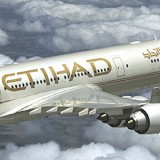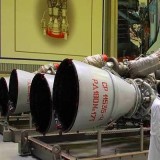US B-1B Lancer Bombers Take Up Position in Japan to Reinforce Deterrence Against China

{loadposition bannertop}
{loadposition sidebarpub}
For the first time since the Vietnam War, U.S. B-1B Lancer strategic bombers are being stationed in Japan for an extended period. This deployment, conducted under a Bomber Task Force (BTF) rotation, marks a significant development in the United States’ military posture in the Indo-Pacific region. The aircraft arrived at Misawa Air Base in northern Japan on April 15, 2025, following a joint mission with South Korean Air Force units over the Korean Peninsula. This action reflects Washington’s intent to strengthen its alliance network in a region facing heightened strategic and military tensions.
Follow Army Recognition on Google News at this link
This deployment is supported by the proven capabilities of the B-1B Lancer, a long-range strategic bomber capable of carrying the largest conventional payload of guided and unguided munitions in the U.S. fleet. (Picture source: PACAF)
The two B-1Bs deployed to Misawa are from the 9th Expeditionary Bomb Squadron and departed from Dyess Air Force Base in Texas to participate in the rotation. Their arrival followed a multilateral training flight involving U.S. F-16s and both F-35s and F-16s from the Republic of Korea Air Force, showcasing a high level of interoperability among allied air forces. Although only two aircraft have been deployed initially, the arrival of additional bombers cannot be ruled out, which would further enhance the U.S. strategic air presence in this key area for regional deterrence.
This deployment is supported by the proven capabilities of the B-1B Lancer, a long-range strategic bomber capable of carrying the largest conventional payload of guided and unguided munitions in the U.S. fleet. Originally designed in the 1980s, the aircraft features a blended wing-body design with variable-geometry wings, afterburning engines, and a structure optimized for survivability. It can reach supersonic speeds (Mach 1.2) while maintaining high maneuverability at both high and low altitudes. Its synthetic aperture radar allows for the detection, tracking, and engagement of mobile targets, even in complex environments, and enables terrain-following flight at low altitude. A GPS-assisted inertial navigation system ensures high-precision targeting without reliance on ground-based systems. These capabilities are further enhanced by the integration of the Link-16 data link, which allows real-time coordination with air command centers and allied platforms in high-value, time-sensitive strike contexts.
In terms of armament, the B-1B can carry up to 34 metric tons of munitions, including general-purpose bombs (Mk-82, Mk-84), cluster munitions (CBU-87, -89, -97), naval mines (Mk-62, Mk-65), precision-guided bombs (GBU-31, GBU-38, GBU-54), and long-range air-to-ground missiles (AGM-158 JASSM and AGM-158C LRASM). This configuration enables it to conduct a wide range of missions, from large-scale conventional strikes to close air support and anti-ship operations. The aircraft is operated by a crew of four, consisting of a pilot, copilot, and two weapon systems officers, and is designed to function effectively in increasingly digitalized and distributed operational environments.
The B-1B’s survivability is further reinforced by a complete suite of electronic countermeasures, including the ALQ-161 jamming system, a radar warning receiver, expendable countermeasures (chaff and flares), and an ALE-50 towed decoy system. Combined with its reduced radar cross-section, this equipment enables the aircraft to penetrate hostile airspace with increased survivability. Since 2011, the B-1B has been limited to conventional missions, following its conversion under the New START Treaty. This process, initiated in 2007, involved both structural modifications and the removal of specific electronic components to render the aircraft incapable of deploying nuclear weapons. Despite this transition, the B-1B remains a core asset in the U.S. conventional strategic arsenal and has demonstrated its effectiveness during multiple campaigns in Iraq, Kosovo, Afghanistan, and more recently in the Middle East, contributing significantly in terms of strike volume and precision.
While U.S. bombers have previously landed in Japan on occasion, this is the first time a Bomber Task Force rotation has involved a prolonged presence in the country. In February 2025, B-1Bs operating from Guam had already conducted a technical stop at Misawa for “hot-pit” refueling—refueling while engines remain on and, in some cases, with a change of crew. This procedure reduces turnaround times and avoids the risks associated with restarting complex systems, thereby optimizing operational tempo in high-intensity scenarios. The use of this method confirms that Misawa Air Base is now fully integrated into the U.S. advanced force posture in the region.
From Misawa, the bombers also have operational access to the Second Island Chain, including Guam and eastern Indonesia, providing strategic depth for potential redeployment or withdrawal as the regional security situation evolves. (Picture source: US DoD)
The Bomber Task Force concept was introduced in 2018 to replace continuous bomber deployments overseas with more flexible, temporary rotations involving small detachments for variable durations. These deployments are intended to provide aircrews with theater familiarization, improve interoperability with regional partners, and maintain a credible forward strategic presence. BTF missions are now routinely conducted in Europe as well as the Indo-Pacific, including rotations to Andersen Air Force Base in Guam, RAAF Amberley in Australia, and Diego Garcia in the Indian Ocean. From these forward positions, U.S. bombers conduct deterrent patrols, surveillance missions, and joint exercises, reinforcing their integration into regional security architectures.
The current deployment to Misawa is part of a broader strategic framework driven by the Pacific Deterrence Initiative, launched in 2021. This initiative seeks to bolster the United States’ long-range strike capabilities in the Pacific, including the deployment of cruise, ballistic, and hypersonic missile systems, as well as manned and unmanned strike platforms. A key component of the strategy involves building resilient precision-strike networks along the First Island Chain, which encompasses Japan, Taiwan, and the Philippines—an area viewed as critical to countering China’s growing regional ambitions. Positioning B-1Bs in this zone enhances the U.S. ability to respond rapidly in a crisis while simultaneously increasing the risk of these assets being targeted on the ground in the event of major conflict.
From Misawa, the bombers also have operational access to the Second Island Chain, including Guam and eastern Indonesia, providing strategic depth for potential redeployment or withdrawal as the regional security situation evolves. In this context, the B-1B’s maritime strike capability becomes particularly relevant. With the integration of the AGM-158C Long-Range Anti-Ship Missile (LRASM), the aircraft is now equipped to conduct high-precision strikes against naval targets. This doctrinal shift aligns with a broader strategic transition emphasizing anti-access and area-denial operations, especially in contested waters such as the Taiwan Strait and South China Sea. Even as it approaches the latter phase of its operational life, the B-1B remains a versatile tool for conventional deterrence in maritime and land-based scenarios.
The BTF 25-2 mission at Misawa thus reflects a deliberate and strategic decision by the United States to reaffirm its commitment to Indo-Pacific stability while strengthening the confidence of its regional allies. According to Lt. Col. Christopher Travelstead, Director of Operations for the deployed 9th Expeditionary Bomb Squadron, such missions ensure that U.S. crews remain prepared to respond at any time to defend national interests and uphold a rules-based regional order. Although the duration of the B-1B presence at Misawa remains undefined, the deployment sends a clear signal to potential adversaries and highlights the adaptability of U.S. forces in a region where the strategic landscape is rapidly evolving.

{loadposition bannertop}
{loadposition sidebarpub}
For the first time since the Vietnam War, U.S. B-1B Lancer strategic bombers are being stationed in Japan for an extended period. This deployment, conducted under a Bomber Task Force (BTF) rotation, marks a significant development in the United States’ military posture in the Indo-Pacific region. The aircraft arrived at Misawa Air Base in northern Japan on April 15, 2025, following a joint mission with South Korean Air Force units over the Korean Peninsula. This action reflects Washington’s intent to strengthen its alliance network in a region facing heightened strategic and military tensions.
This deployment is supported by the proven capabilities of the B-1B Lancer, a long-range strategic bomber capable of carrying the largest conventional payload of guided and unguided munitions in the U.S. fleet. (Picture source: PACAF)
The two B-1Bs deployed to Misawa are from the 9th Expeditionary Bomb Squadron and departed from Dyess Air Force Base in Texas to participate in the rotation. Their arrival followed a multilateral training flight involving U.S. F-16s and both F-35s and F-16s from the Republic of Korea Air Force, showcasing a high level of interoperability among allied air forces. Although only two aircraft have been deployed initially, the arrival of additional bombers cannot be ruled out, which would further enhance the U.S. strategic air presence in this key area for regional deterrence.
This deployment is supported by the proven capabilities of the B-1B Lancer, a long-range strategic bomber capable of carrying the largest conventional payload of guided and unguided munitions in the U.S. fleet. Originally designed in the 1980s, the aircraft features a blended wing-body design with variable-geometry wings, afterburning engines, and a structure optimized for survivability. It can reach supersonic speeds (Mach 1.2) while maintaining high maneuverability at both high and low altitudes. Its synthetic aperture radar allows for the detection, tracking, and engagement of mobile targets, even in complex environments, and enables terrain-following flight at low altitude. A GPS-assisted inertial navigation system ensures high-precision targeting without reliance on ground-based systems. These capabilities are further enhanced by the integration of the Link-16 data link, which allows real-time coordination with air command centers and allied platforms in high-value, time-sensitive strike contexts.
In terms of armament, the B-1B can carry up to 34 metric tons of munitions, including general-purpose bombs (Mk-82, Mk-84), cluster munitions (CBU-87, -89, -97), naval mines (Mk-62, Mk-65), precision-guided bombs (GBU-31, GBU-38, GBU-54), and long-range air-to-ground missiles (AGM-158 JASSM and AGM-158C LRASM). This configuration enables it to conduct a wide range of missions, from large-scale conventional strikes to close air support and anti-ship operations. The aircraft is operated by a crew of four, consisting of a pilot, copilot, and two weapon systems officers, and is designed to function effectively in increasingly digitalized and distributed operational environments.
The B-1B’s survivability is further reinforced by a complete suite of electronic countermeasures, including the ALQ-161 jamming system, a radar warning receiver, expendable countermeasures (chaff and flares), and an ALE-50 towed decoy system. Combined with its reduced radar cross-section, this equipment enables the aircraft to penetrate hostile airspace with increased survivability. Since 2011, the B-1B has been limited to conventional missions, following its conversion under the New START Treaty. This process, initiated in 2007, involved both structural modifications and the removal of specific electronic components to render the aircraft incapable of deploying nuclear weapons. Despite this transition, the B-1B remains a core asset in the U.S. conventional strategic arsenal and has demonstrated its effectiveness during multiple campaigns in Iraq, Kosovo, Afghanistan, and more recently in the Middle East, contributing significantly in terms of strike volume and precision.
While U.S. bombers have previously landed in Japan on occasion, this is the first time a Bomber Task Force rotation has involved a prolonged presence in the country. In February 2025, B-1Bs operating from Guam had already conducted a technical stop at Misawa for “hot-pit” refueling—refueling while engines remain on and, in some cases, with a change of crew. This procedure reduces turnaround times and avoids the risks associated with restarting complex systems, thereby optimizing operational tempo in high-intensity scenarios. The use of this method confirms that Misawa Air Base is now fully integrated into the U.S. advanced force posture in the region.

From Misawa, the bombers also have operational access to the Second Island Chain, including Guam and eastern Indonesia, providing strategic depth for potential redeployment or withdrawal as the regional security situation evolves. (Picture source: US DoD)
The Bomber Task Force concept was introduced in 2018 to replace continuous bomber deployments overseas with more flexible, temporary rotations involving small detachments for variable durations. These deployments are intended to provide aircrews with theater familiarization, improve interoperability with regional partners, and maintain a credible forward strategic presence. BTF missions are now routinely conducted in Europe as well as the Indo-Pacific, including rotations to Andersen Air Force Base in Guam, RAAF Amberley in Australia, and Diego Garcia in the Indian Ocean. From these forward positions, U.S. bombers conduct deterrent patrols, surveillance missions, and joint exercises, reinforcing their integration into regional security architectures.
The current deployment to Misawa is part of a broader strategic framework driven by the Pacific Deterrence Initiative, launched in 2021. This initiative seeks to bolster the United States’ long-range strike capabilities in the Pacific, including the deployment of cruise, ballistic, and hypersonic missile systems, as well as manned and unmanned strike platforms. A key component of the strategy involves building resilient precision-strike networks along the First Island Chain, which encompasses Japan, Taiwan, and the Philippines—an area viewed as critical to countering China’s growing regional ambitions. Positioning B-1Bs in this zone enhances the U.S. ability to respond rapidly in a crisis while simultaneously increasing the risk of these assets being targeted on the ground in the event of major conflict.
From Misawa, the bombers also have operational access to the Second Island Chain, including Guam and eastern Indonesia, providing strategic depth for potential redeployment or withdrawal as the regional security situation evolves. In this context, the B-1B’s maritime strike capability becomes particularly relevant. With the integration of the AGM-158C Long-Range Anti-Ship Missile (LRASM), the aircraft is now equipped to conduct high-precision strikes against naval targets. This doctrinal shift aligns with a broader strategic transition emphasizing anti-access and area-denial operations, especially in contested waters such as the Taiwan Strait and South China Sea. Even as it approaches the latter phase of its operational life, the B-1B remains a versatile tool for conventional deterrence in maritime and land-based scenarios.
The BTF 25-2 mission at Misawa thus reflects a deliberate and strategic decision by the United States to reaffirm its commitment to Indo-Pacific stability while strengthening the confidence of its regional allies. According to Lt. Col. Christopher Travelstead, Director of Operations for the deployed 9th Expeditionary Bomb Squadron, such missions ensure that U.S. crews remain prepared to respond at any time to defend national interests and uphold a rules-based regional order. Although the duration of the B-1B presence at Misawa remains undefined, the deployment sends a clear signal to potential adversaries and highlights the adaptability of U.S. forces in a region where the strategic landscape is rapidly evolving.




